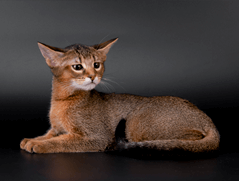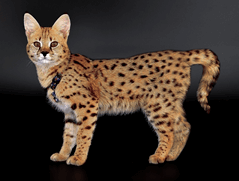 Description of the Chausie breed.
Description of the Chausie breed.
Chausie (Shausi, Housie) is one of the most expensive, beautiful and rare modern cat breeds. Around the world, a few breeders are engaged in this unique elite breed. This is due to the fact that the maintenance and breeding of the Chausie is a laborious process that requires considerable material costs and careful observance of the rules for breeding the breed. Chausie crosses are allowed only with Abyssinian and common phenotypic shorthair cats, other combinations are excluded. In order to preserve the purity of the breed, its unique appearance and character traits, breeders and felinological organizations carefully monitor that real professionals are engaged in breeding.
Chausie with its exotic appearance and harmonious proportions resembles a wild Jungle cat – a tight, slender body, short, dense coat, a medium-long tail, an elegant head crowned with large ears, on which tassels flaunt.
The wild ancestor of the Chausie is the Jungle cat, also called the Swamp lynx, that lives in the Nile Delta, in northeastern Africa, the Middle East, and southeast Asia. The animal got its name from its habitat – these cats are found in reed beds near ponds, lakes, in river basins, where they hunt small animals that live in these reservoirs, they can even feed on frogs. The name of the breed – “Chausie” – comes from the scientific name of its wild ancestor – the Jungle cat – Felis chaus.
It would seem, why breed a new breed, why not just keep wild Jungle cats at home? Firstly, due to the onset of civilization on the traditional habitats of these animals, their number is decreasing, and there is a threat of their transformation into a rare and even endangered species. Secondly, as a result of crossing wild and domestic cats, the problem of preserving the best characteristics of each of the species is solved. For example, breeders noted that the offspring obtained from crossing are more stress-resistant and easier to adapt to the social environment than their ancestors. They become attached to one person and give him their love and devotion. Third, even when tamed, the Jungle cat remains genetically wild. She did not go through the evolutionary path that the domestic cat has overcome together with humans in 10 thousand years of living together. Domestic cats differ from wild ones in that, sharing a home with people, eating our food, they are healthier, live longer and easily adapt to the conditions of coexistence with us. This is the case when a cat and a person evolve together, in the same habitat. The cat gets used to food prepared by man, and, being a very clean animal by nature, it learns to use the litter box, keeping the home clean.
The Jungle cat is not accustomed to keeping clean rooms and eating processed food. People who try to keep Jungle cats at home are faced with the fact that they tend to relieve their natural needs throughout the home and cannot consume regular cat food. They would rather go into the trash can to find the remains of bones, find a way to open the refrigerator and steal raw meat from there, than eat the food you cooked or cat food. And it’s not just a matter of preference. Wild felines have a short digestive tract that is adapted for digesting meat. Toxic and carcinogenic by-products of digestion of meat are quickly eliminated from the short intestine, which prevents their contact with the mucous membrane and the occurrence of bowel cancer. For animals that eat foods of plant origin, a long intestine is needed, in which food remains for a long time and is carefully processed. Animals with short digestive tracts are unable to efficiently digest plant fiber. Their dietary intake of plant-based foods can lead to malnutrition and chronic inflammation of the intestinal mucosa.
Unfortunately, when breeds are crossed, not only useful, but also problematic properties of each of them are preserved. For example, the intestines of a wild cat are shorter than that of a domestic cat, and are not adapted to digest plants, dietary fiber and carbohydrates, which are practically not found in their natural foods. Chausie cats, especially their first generations – the F1 Chausie, inherited a shorter digestive tract from wild cats, therefore, dry food is not suitable for feeding Chausie, since they contain a large amount of cereals. Feeding chausie with dry food can cause diarrhea, which turns into intestinal inflammation. That is why breeders recommend feeding these cats natural fresh meat or high quality wet food with a lot of meat and by-products and give as little plant components and carbohydrates as possible. Due to the fact that Chausie are prone to overeating, it is necessary to control the amount of food they eat.
Breeders and potential owners of these exotic cats pay great attention to their appearance.
The TICA standards stipulate that Chausie have an elongated, toned, strong body without roundness – the body of a real predator, a small head in comparison with the body, which is crowned with large ears with tassels (they are desirable, but the absence of tassels is not considered a marriage of the breed). Long, strong legs are in proportion to the body. The tail must be at least ¾ of the body length; a shorter tail is grounds for disqualification of the animal. These are rather large strong animals, especially the F1, F2, F3 chausie, descended directly from the Jungle cat and having at least 12.5% of the blood of a wild ancestor. The appearance, character and behavior depends on the percentage of blood of the wild ancestor of the Chausie (Felis Chaus) and the domestic cat, which is indicated by the index F and means the generation number:
Chausie F1 – the first generation, direct descendant, 50% of the blood of Felis Chaus (Jungle cat, Reed cat),
Chausie F2 – second generation, 25% Felis Chaus (Jungle cat, Reed cat) blood,
Chausie F3 – third generation, 12.5% Felis Chaus (Jungle cat, Reed cat) blood,
Chausie F4 – fourth generation, 6.25% Felis Chaus (Jungle cat, Reed cat) blood,
Chausie F5 – fifth generation, 3.12% blood of Felis Chaus (Jungle cat, Reed cat), etc.
Particular attention is paid to the color of the Chausie. Three colors are permissible according to the breed standards: black (Grizzly tabby) , ticked tabby and silver ticked.
Ticked tabby (Black Ticked Tabby) color suggests that the entire body of the cat is covered with ticked ones, i.e. striped hairs. In this case, there may be a pattern in the form of spots, stripes or streaks on the body of the animal.
Black tabby – black grizzly (Black Grizzled TickedTabby). Depending on the background color, the color of the Chausie coat can vary from golden to sandy, to tones of gray granite and completely black. Almost all black Chausie have a gray “bloom”, as the hairs of their wool are colored both black and white. The breed standard allows for both pure black and black ticked colors.
The neck, chest, abdomen and inner surface of the paws are usually lighter, up to white, stripes may appear on the outer surface of the paws and tail, the rims of the eyes and pads are white, on the forehead there are markings in the form of the letter “M”. The skin of the nose and paw pads is dark in color.
Chausie’s coat is dense, thick, short, practically does not contain an undercoat and does not require special care. Once a week, it is recommended to brush them with a special massage brush, which will improve the condition of the coat and the blood supply to your pet’s skin.






